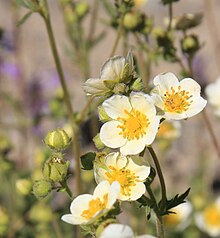Drymocallis glandulosa, formerly Potentilla glandulosa, known by the common names Douglas' wood beauty[1] and sticky cinquefoil, is a plant species in the family Rosaceae.
| Drymocallis glandulosa | |
|---|---|

| |
| In Circle X Ranch Park, Santa Monica Mountains, California | |
| Scientific classification | |
| Kingdom: | Plantae |
| Clade: | Tracheophytes |
| Clade: | Angiosperms |
| Clade: | Eudicots |
| Clade: | Rosids |
| Order: | Rosales |
| Family: | Rosaceae |
| Genus: | Drymocallis |
| Species: | D. glandulosa
|
| Binomial name | |
| Drymocallis glandulosa | |
| Synonyms | |
|
Potentilla glandulosa Lindl. | |

It is native to western North America from southwestern Canada through the far western United States and California, into Baja California.[2] It is widespread and can be found in many types of habitats.
Description
editDrymocallis glandulosa is generally erect in form but it may be small and tuftlike, measuring just a few centimeters high, or tall and slender, approaching 1 metre (3.3 ft) in height. It may or may not have rhizomes.[3]
It is usually coated in hairs, many of which are glandular, giving the plant a sticky texture. The leaves are each divided into several leaflets, with one long terminal leaflet and a few smaller ones widely spaced on each side.
The inflorescence is a cyme of 2 to 30 flowers which are variable in color and size. Each has usually five petals up to a centimeter long which may be white to pale yellow to gold.
Varieties
editIt is highly variable and there are many varieties and subspecies, some of which intergrade and are not clearly defined. They include:[4]
- Drymocallis glandulosa var. glandulosa
- Drymocallis glandulosa var. reflexa
- Drymocallis glandulosa var. viscida
- Drymocallis glandulosa var. wrangelliana
Ecology
editThe plant is more common after its habitat is cleared or disturbed, such as by wildfire, clearcutting, or heavy grazing.[3]
It is an important food for several species of mice, including the western harvest mouse, cactus mouse, and California mouse.[3]
References
edit- ^ a b NatureServe (2 June 2023). "Drymocallis glandulosa". NatureServe Network Biodiversity Location Data accessed through NatureServe Explorer. Arlington, Virginia: NatureServe. Retrieved 20 June 2023.
- ^ USDA, NRCS (n.d.). "Drymocallis glandulosa". The PLANTS Database (plants.usda.gov). Greensboro, North Carolina: National Plant Data Team.
- ^ a b c Reeves, Sonja L. "Potentilla glandulosa". Fire Effects Information System (FEIS). US Department of Agriculture (USDA), Forest Service (USFS), Rocky Mountain Research Station, Fire Sciences Laboratory.
- ^ "Drymocallis glandulosa". Calflora. Berkeley, California: The Calflora Database.
External links
edit- Media related to Drymocallis glandulosa at Wikimedia Commons
- Jepson eFlora, The Jepson Herbarium, University of California, Berkeley
- Potentilla glandulosa in the CalPhotos photo database, University of California, Berkeley
- Drymocallis glandulosa in the CalPhotos photo database, University of California, Berkeley
